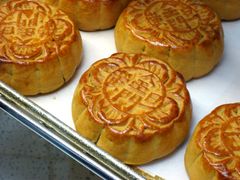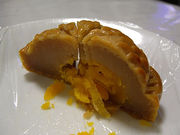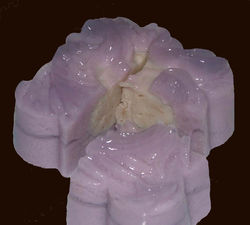Mooncake
| Mooncake | |||||||||||||||||||||||
|---|---|---|---|---|---|---|---|---|---|---|---|---|---|---|---|---|---|---|---|---|---|---|---|
 |
|||||||||||||||||||||||
| Traditional Chinese | 月餅 | ||||||||||||||||||||||
| Simplified Chinese | 月饼 | ||||||||||||||||||||||
| Hanyu Pinyin | yuèbĭng | ||||||||||||||||||||||
| Literal meaning | Moon cake/biscuit | ||||||||||||||||||||||
|
|||||||||||||||||||||||
Mooncakes are Chinese pastries traditionally eaten during the Mid-Autumn Festival / Zhongqiu Festival. The festival is for lunar worship and moon watching; moon cakes are regarded as an indispensable delicacy on this occasion. Mooncakes are offered between friends or on family gatherings while celebrating the festival. The Mid-Autumn Festival is one of the four most important Chinese festivals.
Typical mooncakes are round or rectangular pastries, measuring about 10 cm in diameter and 4-5 cm thick. A thick filling usually made from lotus seed paste is surrounded by a relatively thin (2-3 mm) crust and may contain yolks from salted duck eggs. Mooncakes are usually eaten in small wedges accompanied by Chinese tea.
Contents |
General description

Most mooncakes consist of a thin tender skin enveloping a sweet, dense filling. The mooncake may contain one or more whole salted egg yolks in its center to symbolize the full moon. Very rarely, mooncakes are also served steamed or fried.
Traditional mooncakes have an imprint on top consisting of the Chinese characters for "longevity" or "harmony" as well as the name of the bakery and the filling in the moon cake. Imprints of the moon, the Chang'e woman on the moon, flowers, vines, or a rabbit (symbol of the moon) may surround the characters for additional decoration.
Mooncakes are considered a delicacy; production is labor-intensive and few people make them at home. Most mooncakes are bought at Asian markets and bakeries. The price of mooncakes usually ranges from $10 to $50 (in US dollars) or around £5 to £35 in pounds for a box of four although cheaper and more expensive mooncakes can also be found.
History
Mid-Autumn Festival
The festival is intricately linked to the legends of Chang E, the mythical Moon Goddess of Immortality. According to “Li-Ji”, an ancient Chinese book recording customs and ceremonies, the Chinese Emperor should offer sacrifices to the sun in spring and the moon in autumn. The 15th day of the 8th lunar month is the day called “Mid-Autumn”. The night on the 15th of the 8th lunar month is also called “Night of the Moon”. Under the Song Dynasty (420), the day was officially declared for Mid-Autumn Festival.
Because of its central role in the Mid-Autumn festival, mooncakes remained popular even in recent years. For many, mooncakes form a central part of the Mid-Autumn festival experience such that it is now commonly known as 'Mooncake Festival'.
Ming revolution
There is a folk tale about the overthrow of Mongol rule facilitated by messages smuggled in moon cakes.
Mooncakes were used as a medium by the Ming revolutionaries in their espionage effort to secretly distribute letters in order to overthrow the Mongolian rulers of China in the Yuan dynasty. The idea is said to be conceived by Zhu Yuanzhang (朱元璋) and his advisor Liu Bowen (劉伯溫), who circulated a rumor that a deadly plague was spreading and the only way to prevent it was to eat special mooncakes. This prompted the quick distribution of mooncakes, which were used to hide a secret message coordinating the Han Chinese revolt on the 15th day of the eighth lunar month.[1]
Another method of hiding the message was printed in the surface of mooncakes as a simple puzzle or mosaic. In order to read the encrypted message, each of the four mooncakes packaged together must be cut into four parts each. The 16 pieces of mooncake, must then be pieced together in such a fashion that the secret messages can be read. The pieces of mooncake are then eaten to destroy the message.[2][3]
Traditional cake
Fillings

Many types of fillings can be found in traditional mooncakes according to the region's culture:
- Lotus seed paste (蓮蓉, lían róng): Considered by some to be the original and most luxurious mooncake filling, lotus paste filling is found in all types of mooncakes. Due to the high price of lotus paste, white kidney bean paste is sometimes used as a filler.
- Sweet bean paste (豆沙, dòu shā): A number of pastes are common fillings found in Chinese desserts. Although red bean paste, made from azuki beans, is the most common worldwide, there are regional and original preferences for bean paste made from Mung bean as well as black bean known throughout history.
- Jujube paste (棗泥, zǎo ní): A sweet paste made from the ripe fruits of the jujube (date) plant. The paste is dark red in colour, a little fruity/smoky in flavour and slightly sour in taste. Depending on the quality of the paste, jujube paste may be confused with red bean paste, which is sometimes used as a filler.
- Five kernel (五仁, wǔ rén): A filling consisting of 5 types of nuts and seeds, coarsely chopped and held together with maltose syrup. Recipes differ from region to region, but commonly used nuts and seeds include: walnuts, pumpkin seeds, watermelon seeds, peanuts, sesame, or almonds. In addition, the mixture will usually contain candied winter melon, jinhua ham, or pieces of rock sugar as additional flavouring.
- Taro Paste (芋泥, yù ní): A sweet paste made from taro, a tuber grown in many parts of tropical Asia. The colour of the paste in the mooncake is purple and is most commonly used in Teochew crusty mooncakes.
- Salt and pepper (椒鹽, jiāoyán): Filling made from roasted black sesame. Commonly found in flaky Suzhou-style mooncakes.
- Durian: Filling commonly found in South East Asia (mainly Indonesia, Malaysia, Thailand and Singapore) made of mashed durian paste.
Crusts
Traditional mooncake vary widely depending on the region where the mooncake is produced. While most regions produce traditional mooncakes with many types of fillings, they usually only make their mooncake from one type of crust or another. Although vegetarian mooncakes may use vegetable oil, many mooncakes use lard in their recipes for a better taste. There are three types of mooncake crust used in Chinese cuisine:
- Chewy: This crust has a reddish-brown tone and glossy sheen. It is the most common type of crust used on Cantonese-style mooncakes. It is also the most commonly seen type of mooncake in North America and many western countries. Chewy mooncake crusts are made using a combination of thick sugar syrup, lye water, flour, and oil, thus giving this crust its rich taste and a chewy yet tender texture. Chewiness can be increased further by adding maltose syrup to the mixture.
- Flaky: Flaky crusts are most indicative of Suzhou-style mooncakes. The dough is made by rolling together alternating layers of oily dough and flour that has been stir-fried in oil. This crust has a very similar texture to the likes of puff pastry.
- Tender: Mooncakes from certain provinces of China and Taiwan are often made to be tender rather than flaky or chewy. The texture of this type of mooncake crust is similar to the likes of the shortcrust pastry used in Western pie crusts or tart shells. Tender crusts are made mainly of a homogenous mix of sugar, oil, flour, and water. This type of crust is also commonly used in other type of Chinese pastries, such as the egg tart.
Regional variations in China
There are many regional variants of the mooncake. Types of traditional mooncakes include:
- Cantonese-style mooncake: Originating from Guangdong province, the Cantonese style mooncake has multiple variations. The ingredients used for the fillings are various: lotus seed paste, melon seed paste, ham, chicken, duck, roast pork, mushrooms, egg yolks, etc. More elaborate versions contain four egg yolks, representing the four phases of the moon. Recent contemporary forms (albeit non-traditional) sold in Hong Kong are even made from chocolate, ice-cream or jelly. [4]
- Suzhou-style mooncake:: This style began more than a thousand years ago, and is known for its layers of flaky dough and generous allotment of sugar and lard. Within this regional type, there are more than a dozen variations. It is also smaller than most other regional varieties. Suzhou-style mooncakes feature both sweet and savoury types, the latter served hot and usually filled with pork mince.
- Beijing-style mooncake: This style has two variations. One is called "di qiang," which was influenced by the Suzhou-style mooncake. It has a light foamy dough as opposed to a flaky one. The other variation is called "fan mao" and has a flaky white dough. The two most popular fillings are the mountain hawthorn and wisteria blossom flavour. The Beijing-style mooncake is often meticulously decorated.
- Chaoshan (Teochew)-style mooncake: This is another flaky crust variety, but is larger in size than the Suzhou variety. It is close in diameter to the Cantonese style, but thinner in thickness. A variety of fillings are used, but the aroma of lard after roasting is emphasised.
- Ningbo-style mooncake: This style is also inspired by the Suzhou-style. It is prevalent in Zhejiang province and has a compact covering. The fillings are either seaweed or ham; it is also known for its spicy and salty flavour.
- Yunnan-style mooncake: Also known as "t'o" to the residents, its distinctive feature is the combination of various flours for the dough and includes rice flour, wheat flour, buckwheat flour, and more. Most of the variations within this style are sweet.
Modern cake

Modern mooncakes resemble the traditional type although with certain modifications. Part of the reason is that people are becoming more health-conscious. Traditional mooncakes are made with lard, and a lot of sugar. Another reason that the traditional mooncake has undergone a successful diversification is its popularity. It has become so popular that many mooncakes are bought by businessmen who present them to their clients as presents[5]. Modern mooncakes differ most greatly in the type of fillings that are offered. For instance, mooncakes containing taro paste and pineapple, which were considered novelty items at their time of invention have in recent years become commonplace items. In addition, filling with ingredients such as coffee, chocolate, nuts (walnuts, mixed nuts, etc), fruits (prunes, pineapples, melons, lychees etc), vegetables (sweet potatoes, etc), and even ham have been added to give a modern twist to the traditional recipes. To adapt to today’s health-conscious lifestyle, many bakeries offer miniature mooncakes and fat-free mooncakes. Some are made of yogurt, jelly, and fat-free ice-cream. Even high-fibre low-sugar mooncakes have made their appearance. Customers pick and choose the size and filling of mooncakes that suits their taste and diet. For added hygiene, each cake is often wrapped in airtight plastic, accompanied by a tiny food preserver packet. Modern mooncakes are well-accepted among young people in China.
Fillings
Snowy mooncakes first appeared on the market in the early 1980s. These non-baked, chilled mooncakes were initially filled with traditional fillings such as lotus seed, red bean, or mung bean paste. Häagen-Dazs were one of the first to create an ice-cream mooncake, with a choice of either the "traditional," snow-skin, or Belgian white, milk, and dark chocolate crusts. Moon Cakes have lately become Americanized very much in the United States. Instead of a filling of egg yolk, you can have them filled with marshmallows or chocolate.
Following this bit of lateral thinking, it was obvious these non-baked mooncakes could be filled with pretty much anything that could be made into a paste. A wave of new flavours appeared spanning from:
White kidney bean paste or plain ice-cream are usually used as a base of flavours such as green tea, coffee, or ginseng, which are not thick enough or cannot be usually in large enough quantities to be a filling on their own.
Crusts

Modern varieties of mooncakes are also different from their traditional counterparts in that their crusts typically do not require baking. However, they require refrigerating. There are two main varieties of modern mooncake crusts:
- Glutinous rice: A crust with texture similar to that of a mochi. These moon cakes are known colloquially as "snowskin mooncakes" or "ice-skin mooncakes" (冰皮 or 冰皮月餅).
- Jelly: A crust made of gelling mixtures such as agar, gelatin, or konjac and flavoured with a wide variety of fruit flavourings.
Use in other countries or regions

Taiwan
The most traditional mooncake from Taiwan is filled with yam[6].Taiwanese moon cakes are wide in variety that include low fat, lard free and ice cream versions. Popular modern flavors include green tea, chocolate and many others.
Indonesia
In Indonesia, there are hundreds of types of moon cakes, from the traditional to the modern mooncakes. The very traditional mooncake has been there ever since the Chinese and Japanese entered Indonesia, they are circular like a moon, white and rather thin. Fillings may include chocolate, cheese, milk, durian, jackfruit and many other exotic fruits, however before 1998 it was only sold in small markets or villages. Now the traditional moon cake is easy to find in supermarkets and mini marts, rather than the modern mooncakes.
The "modern" mooncakes finally entered Indonesia after 1998.
Japan
In Japan, mooncakes are sold year-round, mainly in Japan's Chinatowns, pronounced in Japanese as "geppei". Azuki (Red Bean) paste is the most popular filling for these mooncakes, but other sorts of beans as well as chestnut are also used. Unlike some types of Chinese mooncakes, mooncakes in Japan almost never contain an egg yolk in the center.
Vietnam
In Vietnam, mooncakes are known as bánh trung thu (literally "Mid-Autumn cake") and may contain a variety of fillings, such as savory roasted chicken, mung beans, coconut or durian.
Philippines
In the Philippines, the mooncake is known locally as Hopia, and has a number of variants including Hopia Mungo, Hopia Baboy, Hopia Hapon, and Hopia Ube.
See also
- Chinese cuisine
- Suncake
- Mid-Autumn Festival
References
- ↑ Taipeitimes news
- ↑ Family culture
- ↑ China inc
- ↑ 鳳凰衛視中文台, 12 September 2008
- ↑ Asianweek
- ↑ http://blog.sina.com.tw/extrablue/article.php?pbgid=22988&entryid=159897
External links
|
||||||||||||||||||||||||||
|
||||||||